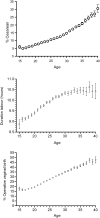The ageing ovary and uterus: new biological insights
- PMID: 23103636
- PMCID: PMC3508627
- DOI: 10.1093/humupd/dms043
The ageing ovary and uterus: new biological insights
Abstract
BACKGROUND Advanced maternal age is associated with reduced fertility and adverse pregnancy outcomes. This review details recent developments in our understanding of the biology and mechanisms underlying reproductive ageing in women and the implications for fertility and pregnancy. METHODS Sociological online libraries (IBSS, SocINDEX), PubMed and Google Scholar were searched for relevant demographic, epidemiological, clinical and biological studies, using key words and hierarchical MeSH terms. From this, we identified and focused on key topics where it was judged that there had been clinically relevant advances in the understanding of ovarian and uterine ageing with implications for improved diagnostics and novel interventions. RESULTS Mapping of the ovarian reserve, follicular dynamics and associated biomarkers, across the reproductive lifespan has recently been performed. This now allows an assessment of the effects of environmental, lifestyle and prenatal exposures on follicular dynamics and the identification of their impact during periods of germ cell vulnerability and may also facilitate early identification of individuals with shorter reproductive lifespans. If women choose to time their family based on their ovarian reserve this would redefine the meaning of family planning. Despite recent reports of the potential existence of stem cells which may be used to restore the primordial follicle and thereby the oocyte pool, therapeutic interventions in female reproductive ageing at present remain limited. Maternal ageing has detrimental effects on decidual and placental development, which may be related to repeated exposure to sex steroids and underlie the association of ageing with adverse perinatal outcomes. CONCLUSIONS Ageing has incontrovertible detrimental effects on the ovary and the uterus. Our enhanced understanding of ovarian ageing will facilitate early identification of individuals at greatest risk, and novel therapeutic interventions. Changes in both ovary and uterus are in addition to age-related co-morbidities, which together have synergistic effects on reducing the probability of a successful pregnancy outcome.
Figures





References
-
- Aagesen L, Grinsted J, Mikkelsen M. Advanced grandmaternal age on the mother's side—a risk of giving rise to trisomy 21. Ann Hum Genet. 1984;48:297–301. - PubMed
-
- Abbott DH, Barnett DK, Bruns CM, Dumesic DA. Androgen excess fetal programming of female reproduction: a developmental aetiology for polycystic ovary syndrome? Hum Reprod Update. 2005;11:357–374. - PubMed
-
- Aldous MB, Edmonson MB. Maternal age at first childbirth and risk of low birth weight and preterm delivery in Washington State. J Am Med Assoc. 1993;270:2574–2577. - PubMed
-
- Almog B, Shehata F, Shalom-Paz E, Tan SL, Tulandi T. Age-related normogram for antral follicle count: McGill reference guide. Fertil Steril. 2011;95:663–666. - PubMed
Publication types
MeSH terms
Grants and funding
LinkOut - more resources
Full Text Sources
Other Literature Sources
Medical

